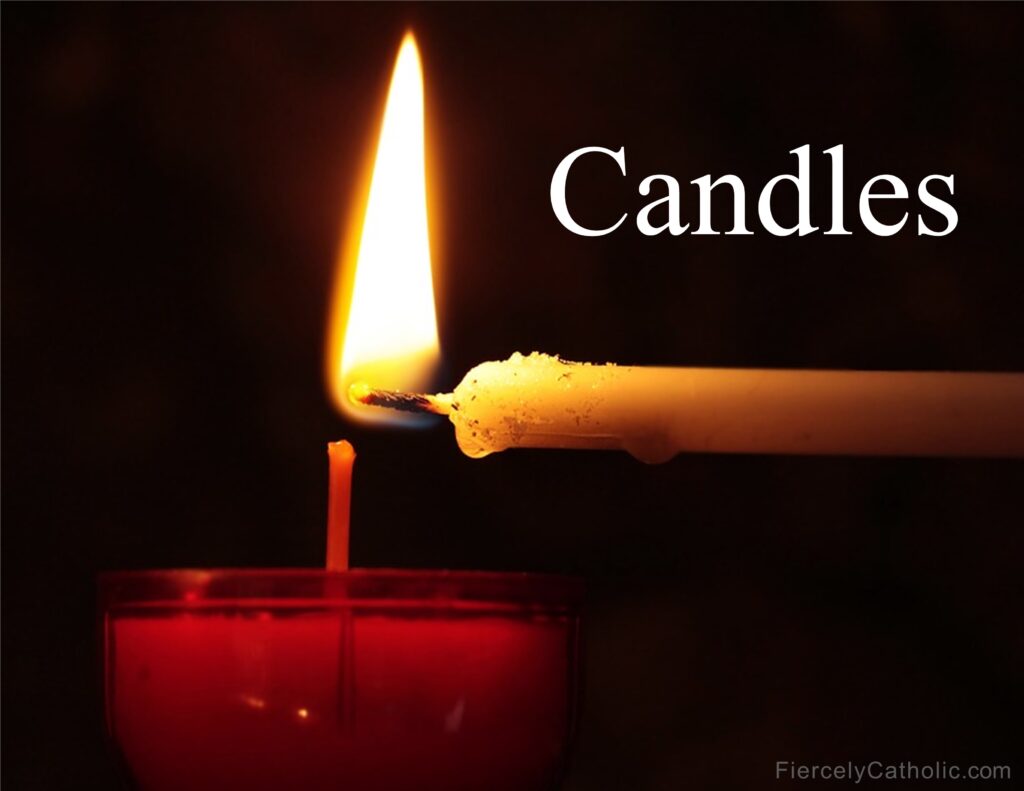
In the Catholic Church, candles serve practical, decorative, and liturgical purposes.
Jesus said that He was the Light of the World and He wanted his light to be spread throughout the world by his Church.
Candles provide light and the grace and beauty they represent contribute to veneration and indicate the solemnity of the liturgy.
Candles are part of God’s creation and by using and enjoying them we are reminded of the power of God.
The flames from a group of votive candles remind us that our prayers continue while they are joined with the prayers of others.
Catholics light the large Paschal candle that serves as a symbol of Jesus during certain liturgies and seasons while the perpetual light of the sanctuary candles near the tabernacle indicates that Jesus is truly present in the Eucharist.
Celebrations of Candlemas, Advent, Easter, and the Feast of St. Blaise also feature candles with special significance.
It is his light:
Spreading the light of Christ:
In the beginning was the Word, and the Word was with God, and the Word was God. He was in the beginning with God. All things came to be through Him, and without Him nothing came to be. What came to be through Him was life, and this life was the light of the human race; the light shines in the darkness, and the darkness has not overcome it.
John 1: 1-5
On fire with the love of Jesus:
Sharing the light of Jesus with others:
Giving what you cannot take back:
Here is the first symbolic gesture of the solemn Easter Vigil : the deacon carries the candle, the symbol of Christ the light of the world, inside the basilica immersed in darkness. From the “new fire” of this candle the flames of some candles are lit, and from these, little by little, the candles of all the faithful, until the temple is filled with light. The deacon then sings the Easter Preconio, which is the hymn to Christ-Light . In the night praise is raised to the Redeemer, who from the darkness led us to the wonderful light of God. “O felix culpa, quae talem ac tantum meruit habere Redemptorem! Happy sin, who deserved to have such a great Redeemer!” So great are the joy and the wonder for the salvation received as a gift, that the fault itself seems worthy of being blessed! What, in fact, is darkness if not the symbol of sin and death? And what is light if not the symbol of life overcoming death?
Pope John Paul II, Easter Vigil Homily, April 6, 1996
A visual representation of love and prayer:
Christ shines through the darkness:
The liturgical celebration involves signs and symbols relating to creation (candles, water, fire), human life (washing, anointing, breaking bread) and the history of salvation (the rites of the Passover). Integrated into the world of faith and taken up by the power of the Holy Spirit, these cosmic elements, human rituals, and gestures of remembrance of God become bearers of the saving and sanctifying action of Christ.
Catechism of the Catholic Church 1189
Different candles have different significance:
Candles have served practical and spiritual purposes in the Church:
The Truth, Goodness, and Beauty of the Catholic Church
My favorite prayer:
Share this page with friends and family to start a conversation about your faith.
Don’t miss a post. Learn more about the Catholic Church and strengthen your Catholic faith.
Find more Fiercely Catholic video issues here.
Subscribe here.


